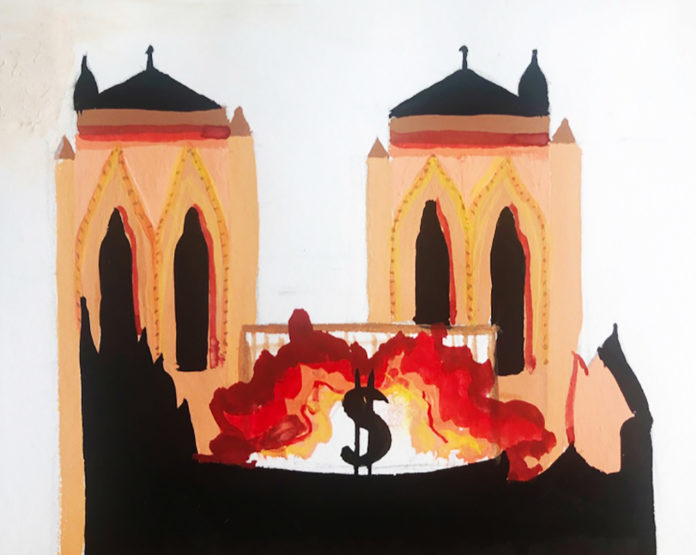The April 15 fire at Notre Dame Cathedral in Paris represents one of the greatest artistic and cultural losses of our time. The value of the cathedral, an icon for France and a highlight of Gothic architecture, cannot be understated. The massive outpouring of money and support for efforts to rebuild the lost sections suggests that the world yearns to see the cathedral restored. However, I would argue that the support is misguided.
Yes, hell has frozen over — an art history major thinks the rebuilding of Notre Dame is overhyped.
While I can already hear my adviser cursing my name, I believe we should shift our restoration priorities elsewhere. That’s not to say that we shouldn’t restore Notre Dame — we should — but we should not do so at the expense of other vulnerable sites that lack the privilege of Notre Dame. Furthermore, we must make efforts to preserve the cultural sites we already have.
Built from 1163 to 1345, the Notre Dame cathedral is one of the world’s most iconic architectural works. Approximately 13 million people flock to see Notre Dame every year, and popular culture has immortalized its image through films and video games. The fire drastically altered the cathedral, destroying much of the wooden interior, collapsing the ceiling and possibly jeopardizing the limestone supports.
After the fire, various private donors committed more than one billion dollars and counting to restore Notre Dame, with significant portions coming from French and American companies. The French government also pledged to restore the cathedral, with French president Emmanuel Macron setting the ambitious goal of completing the project within five years. Even President of the United States Donald Trump chimed in to offer assistance in the restoration process.
At the same time, however, other important cultural sites are falling into disrepair. The United Nations Education, Scientific and Cultural Organization (UNESCO) classifies 54 sites of significant cultural value as “in danger,” yet many have not gotten the same attention that Notre Dame is currently receiving. For example, UNESCO lists the Birthplace of Jesus in the Church of Nativity in Palestine as in need of support to ensure its preservation. Despite being the birthplace of a major religious figure, the world has not exactly leapt at the chance to preserve the site. The nearby Al-Asqa Mosque in Jerusalem caught fire the same week as Notre Dame, yet little attention and funds have been directed at a mosque known as the third holiest site within the Islamic faith.
Culturally valuable places within our own country have been overlooked, too. Three black churches in Louisiana burned as a result of alleged hate crimes March 26, April 2 and April 6. While efforts to restore the churches progress steadily, they have not received the same adoring support as Notre Dame, and the federal government has yet to pledge any financial support to those efforts.
Choosing to protect these spaces is just as important, if not more, than donating more money to repair Notre Dame. For one, it speaks to what art and whose history are prioritized within our society. It’s not surprising that the U.S. offered money to France, considering our relationship with that country. But neglecting cultural sites at home gives the impression that those sites are simply not as valuable as the Notre Dame Cathedral.
Furthermore, neglecting these sites when we have the means to protect and restore them proves downright foolish. If L’Oreal took the 200 million euros they donated to restore Notre Dame and put it toward other vulnerable sites, a significant amount of world history and culture could be preserved.
The fire at Notre Dame can teach us to become good stewards of culture and history. On one hand, we must take better care of the structures we already have. The New York Times noted that the Notre Dame fire could have been prevented by the implementation of modern amenities such as sprinklers and fire-resistant walls. French authorities rejected these measures, believing they would compromise the structure, yet now they must restore that which they sought to protect. To avoid the same mistake, we must make an effort to keep what we already have intact; an ounce of proactive preservation can prevent unquantifiable loss later.
It also falls upon us to consider what we choose to restore and protect. It is difficult to imagine a reality in which the French government did not choose to restore Notre Dame, even sans private donors. Yet, the same cannot be said for other significant spaces. We must work to identify vulnerable cultural sites and direct our efforts to preserve them. That means donating to efforts directed at vulnerable sites and working to spread awareness. We must also put pressure on those with the resources to create significant change; if companies can swoop in at a moment’s notice to assist with Notre Dame, they can aid other projects.
It’s fair to support efforts to restore Notre Dame, but to do so when many other sites remain vulnerable may cost us much more than the roof of a cathedral. Such negligence disregards the importance of some cultures and puts key historical sites in jeopardy; while Notre Dame has the name recognition and attention to power its restoration, other places are not so lucky. To lose them would be everyone’s loss.
Pablo Nukaya-Petralia is a junior art and art history major. He can be reached at pnukayapetra@oxy.edu.
![]()



































